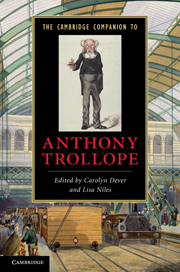Book contents
- Frontmatter
- Introduction
- 1 Trollope’s Literary Life and Times
- 2 Trollope As Autobiographer And Biographer
- 3 Trollope’s Barsetshire Series
- 4 The Palliser Novels
- 5 Trollope Redux: The Later Novels
- 6 Trollope’s Short Fiction
- 7 Trollope And The Sensation Novel
- 8 Queer Trollope
- 9 The hobbledehoy in Trollope
- 10 The construction of masculinities
- 11 Vulgarity and money
- 12 Trollope and the law
- 13 Trollope and travel
- 14 Trollope and the Antipodes
- 15 Trollope and Ireland
- 16 Trollope and America
- Further reading
- Index
- Cambridge Companions to . . .
8 - Queer Trollope
Published online by Cambridge University Press: 28 March 2011
- Frontmatter
- Introduction
- 1 Trollope’s Literary Life and Times
- 2 Trollope As Autobiographer And Biographer
- 3 Trollope’s Barsetshire Series
- 4 The Palliser Novels
- 5 Trollope Redux: The Later Novels
- 6 Trollope’s Short Fiction
- 7 Trollope And The Sensation Novel
- 8 Queer Trollope
- 9 The hobbledehoy in Trollope
- 10 The construction of masculinities
- 11 Vulgarity and money
- 12 Trollope and the law
- 13 Trollope and travel
- 14 Trollope and the Antipodes
- 15 Trollope and Ireland
- 16 Trollope and America
- Further reading
- Index
- Cambridge Companions to . . .
Summary
They’re a queer lot, – ain’t they, – the sort of people one meets about in the world?
Lord Carruthers (ED ch. 75)Trollope’s fiction contains a number of characters who are described as “queer.” In Barchester Towers, the Archdeacon talks to his wife about the new vicar, the Reverend Francis Arabin, who is coming to stay with them. “‘He’s very queer, isn’t he?’ asked the wife. ‘Well – he is a little odd in some of his fancies; but there’s nothing about him you won’t like . . .’” (BT ch. 14). Attending a dinner at Gatherum Castle in Doctor Thorne, Frank asks his clergyman friend Mr. Athill about the other guests: “Who is that funny little man sitting there. . .? I never saw such a queer fellow in my life” – the object of scrutiny is the former apothecary, Mr. Bolus (DT ch. 19). In the same novel, Frank remarks of his sister’s fiance´, the ambitious and unreliable Mr. Moffat, that “for an engaged lover he seems to me to have a very queer way with him.” To a modern reader, the nature of this queerness seems plain enough: “he was a nice, dapper man,” we are told, with “very nicely brushed” dark hair, carefully trimmed whiskers, “very white” hands; he has a limp handshake, he simpers, he speaks in “a pretty, mincing voice.” He seems remarkably reticent for a supposedly enthusiastic suitor: “Frank, poor fellow! who was of a coarser mould, would, under such circumstances, have been all for kissing” (DT ch. 15).
- Type
- Chapter
- Information
- The Cambridge Companion to Anthony Trollope , pp. 99 - 112Publisher: Cambridge University PressPrint publication year: 2010

